Electrical Instrumentation at UST
A research group that develops electrical instrumentation for challenges in detection within the Electrical and Computer Engineering department at the University of St. Thomas.
Biography
Lucas Koerner is an associate professor of electrical and computer engineering at the University of St. Thomas (UST). His research group develops and applies electronics and optical systems for challenges in measurement science. He enjoys teaching undergraduate electronics, especially at the intersection between electrical engineering and physics.
- Electronics for Photon Detection and Scientific Experiments
- Instrument Control
- Integrated Circuit Testing
-
Ph.D. in Physics, 2010
Cornell University
-
M.S. in Physics, 2007
Cornell University
-
B.A. in Integrated Science Program, Physics, and Mathematics, 2003
Northwestern University
Projects
Student Researchers
Featured Publications
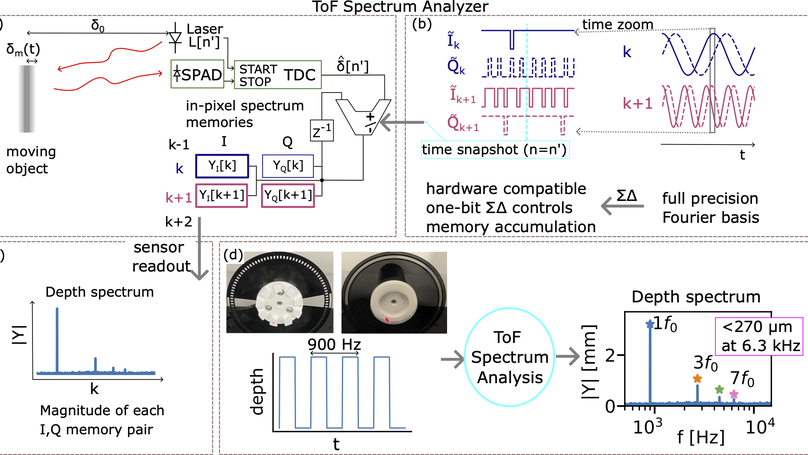
Time-of-flight (ToF) sensors with single-photon avalanche diodes (SPADs) estimate depth by accumulating a histogram of photon return times, which discards the timing information required to measure depth dynamics, such as vibrations or transient motions. We introduce a method that transforms a direct ToF sensor into a depth frequency analyzer capable of measuring high-frequency motion and transient events using only lightweight, on-sensor computations. By replacing conventional discrete Fourier transforms (DFTs) with one-bit probing sinusoids generated via oversampled sigma-delta modulation, we enable in-pixel frequency analysis without multipliers or floating-point operations. We extend the lightweight analysis of depth dynamics to Haar wavelets for time-localized detection of brief, non-repetitive depth changes. We validate our approach through simulation and hardware experiments, showing that it achieves noise performance approaching that of full-resolution DFTs, detects sub-millimeter motions above 6 kHz, and localizes millisecond-scale transients. Using a laboratory ToF setup, we demonstrate applications in oscillatory motion analysis and depth edge detection. This work has the potential to enable a new class of compact, motion-aware ToF sensors for embedded deployment in industrial predictive maintenance, structural health monitoring, robotic perception, and dynamic scene understanding.
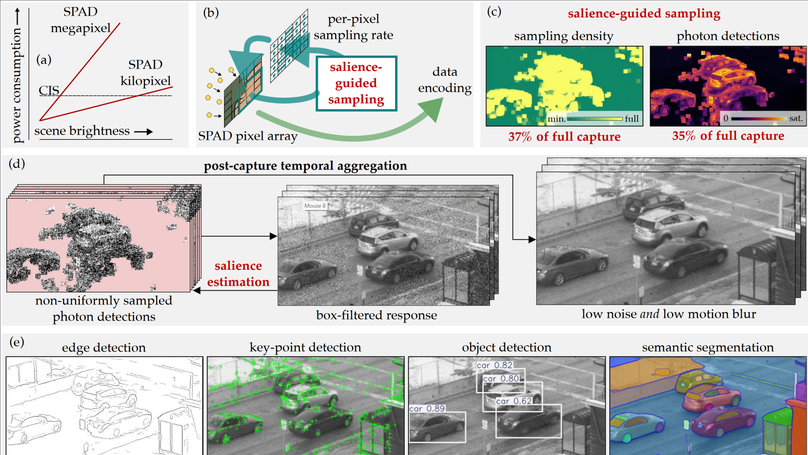
Single-photon avalanche diodes (SPAD) detect individual photons with fine temporal resolutions, enabling capabilities like imaging in near-total darkness, extreme dynamic range, and rapid motion. Due to these capabilities, and coupled with the recent emergence of high-resolution (>1 MP) arrays, SPADs have the potential to become workhorses for computer vision systems of the future that need to operate in a wide range of challenging conditions. However, SPADs’ sensitivity comes at a high energy cost due to the underlying avalanche process, which consumes substantial energy per detected photon, limiting the scalability and practicality of high-resolution SPAD arrays. To address this, we propose approaches to predict and sample only the most salient photons for a given vision task. To this end, we design computationally lightweight photon-sampling strategies that allocate energy resources for detecting photons only in areas with significant motion and spatial variation, while continually adapting to changing signals. We demonstrate the effectiveness of the proposed methods in recovering comparable video to a fully-sampled SPAD capture using only a small fraction of the photons (up to 10× fewer), across diverse real-world scenes with motion, high dynamic range, and varying light conditions.
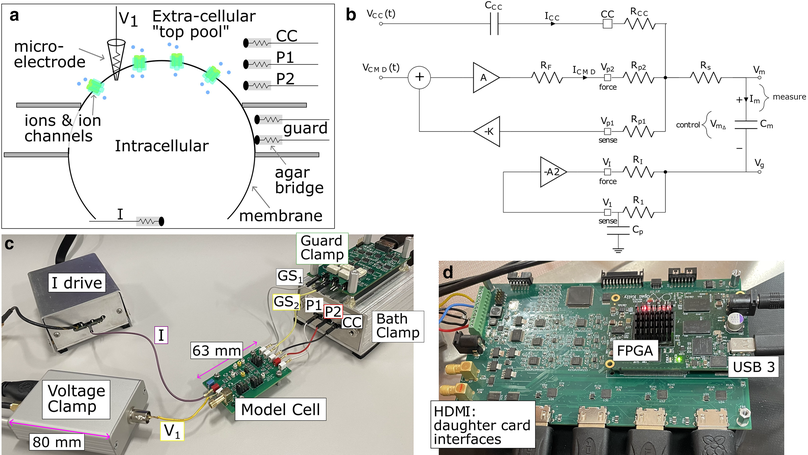
The cut-open oocyte Vaseline gap technique is a powerful electrophysiological method for the characterization of ion channels. However, traditional amplifiers for cut-open oocyte Vaseline gap are labor intensive and require significant user expertise. We introduce an innovative, open-source digital amplifier system with high-speed digitization and software-controlled electronics for computer-driven automation. This system compares well to existing commercial systems in terms of conventional specifications of step response (current peak at 25 us and decay of 36 us time constant), current noise (1.0 nA at 3-kHz bandwidth), and dynamic range (96.9 dB). Additionally, it unlocks new methods through close integration of the amplifier and software, including machine-learning techniques for tuning capacitive compensation waveforms, achieving a 100-fold suppression of mean-squared transient current, and impedance measurement methods to identify system components such as membrane capacitance and electrode resistances. For future extensions, the design has unique attributes such as real-time digital signal processing for feedback, multiple input and multiple output, and allows for user customization. By providing open-source access to the circuit board designs, control software, and field-programmable gate array code on GitHub, this approach aims to foster cross-disciplinary collaboration and facilitate instrument customization enabling previously inaccessible electrophysiology experiments.
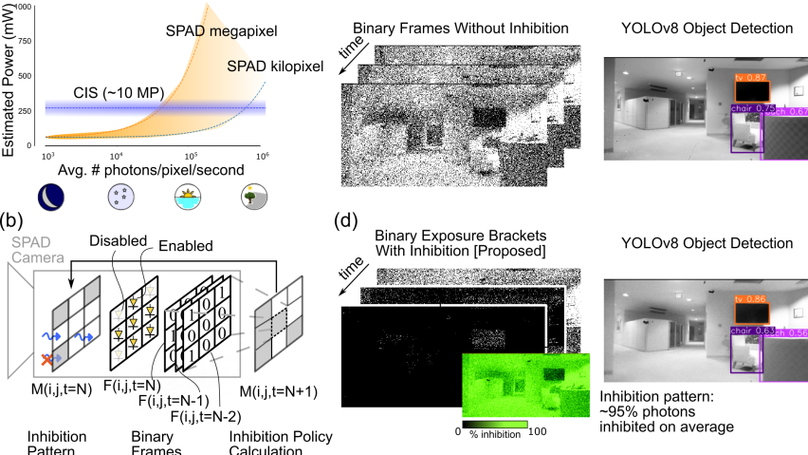
Single-photon cameras (SPCs) are emerging as sensors of choice for various challenging imaging applications. One class of SPCs based on the single-photon avalanche diode (SPAD) detects individual photons using an avalanche process; the raw photon data can then be processed to extract scene information under extremely low light, high dynamic range, and rapid motion. Yet, single-photon sensitivity in SPADs comes at a cost—each photon detection consumes more energy than that of a CMOS camera. This avalanche power significantly limits sensor resolution and could restrict widespread adoption of SPAD-based SPCs. We propose a computational-imaging approach called photon inhibition to address this challenge. Photon inhibition strategically allocates detections in space and time based on downstream inference task goals and resource constraints. We develop lightweight, on-sensor computational inhibition policies that use past photon data to disable SPAD pixels in real-time, to select the most informative future photons. As case studies, we design policies tailored for image reconstruction and edge detection, and demonstrate, both via simulations and real SPC captured data, considerable reduction in photon detections (over 90% of photons) while maintaining task performance metrics. Our work raises the question of “which photons should be detected?”, and paves the way for future energy-efficient single-photon imaging. Source code for our experiments is available at https://wisionlab.com/project/inhibition.
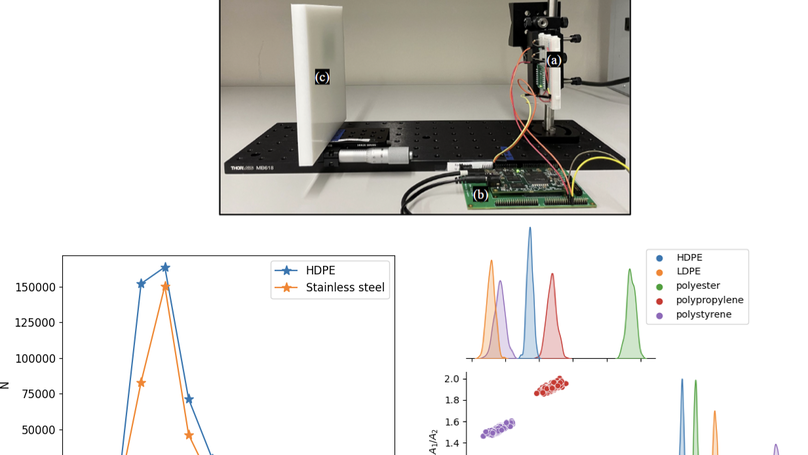
We demonstrate a methodology for non-contact classification of five different plastic types using an inexpensive direct time-of-flight (ToF) sensor, the AMS TMF8801, designed for consumer electronics. The direct ToF sensor measures the time for a brief pulse of light to return from the material with the intensity change and spatial and temporal spread of the returned light conveying information on the optical properties of the material. We use measured ToF histogram data of all five plastics, captured at a range of sensor to material distances, to train a classifier that achieves 96% accuracy on a test dataset. To extend the generality and provide insight into the classification process, we fit the ToF histogram data to a physics-based model that differentiates between surface scattering and subsurface scattering. Three optical parameters of the ratio of direct to subsurface intensity, the object distance, and the time constant of the subsurface exponential decay are used as features for a classifier that achieves 88% accuracy. Additional measurements at a fixed distance of 22.5 cm showed perfect classification and revealed that Poisson noise is not the most significant source of variation when measurements are taken over a range of object distances. In total, this work proposes optical parameters for material classification that are robust over object distance and measurable by miniature direct time-of-flight sensors designed for installation in smartphones.
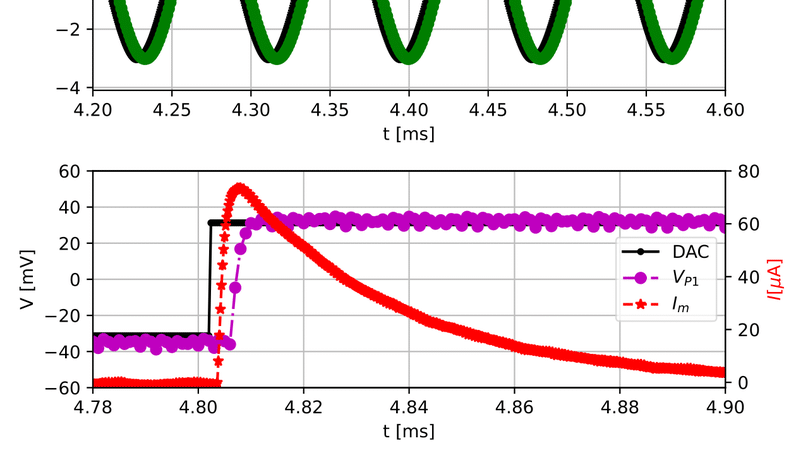
We describe a custom and open source field-programmable gate array (FPGA)-based data acquisition (DAQ) system developed for electrophysiology and generally useful for closed-loop feedback experiments. FPGA acquisition and processing are combined with high-speed analog and digital converters to enable real-time feedback. The digital approach eases experimental setup and repeatability by allowing for system identification and in situ tuning of filter bandwidths. The FPGA system includes I2C and serial peripheral interface controllers, 1 GiB dynamic RAM for data buffering, and a USB3 interface to Python software. The DAQ system uses common HDMI connectors to support daughtercards that can be customized for a given experiment to make the system modular and expandable. The FPGA-based digital signal processing (DSP) is used to generate fourth-order digital infinite impulse response filters and feedback with microsecond latency. The FPGA-based DSP and an analog inner-loop are demonstrated via an experiment that rapidly steps the voltage of a capacitor isolated from the system by a considerable resistance using a feedback approach that adjusts the driving voltage based on the digitized capacitor current.
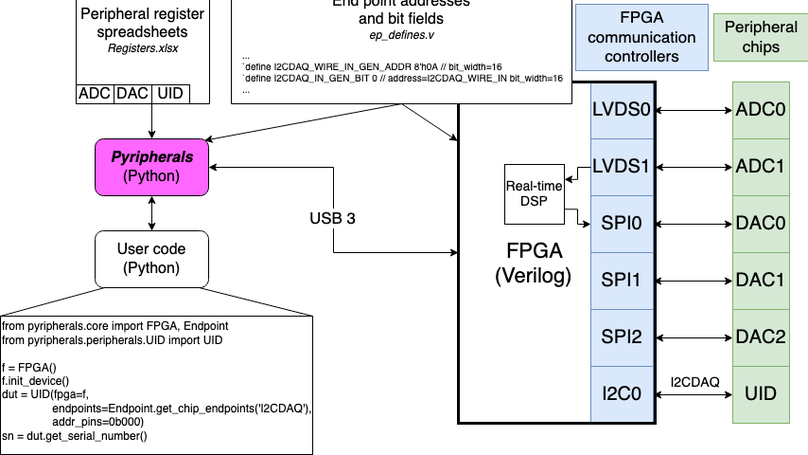
We are developing a data acquisition system (DAQ) for real-time feedback that uses FPGA based control of and acquisition from various electronic chips, or peripherals. Because these peripherals communicate over multiple protocols (SPI, I2C, LVDS) through an FPGA, we designed pyripherals to organize and abstract registers, the communication protocol, and the host computer interface to each communication controller. The software and firmware are designed for Opal Kelly FPGA modules, yet the Python developments are generally useful to organize communication with peripheral chips.
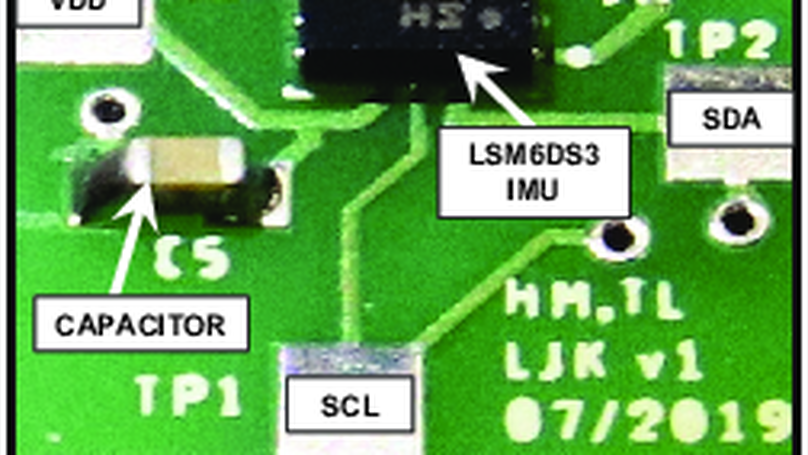
Transcathether aortic heart valve replacement (TAVR) is a widespread approach to treating patients with severe aortic stenosis. A TAVR implant is ideally positioned to access numerous clinically relevant signals including arterial blood pressure, pulse wave velocity, electrocardiogram (ECG), patient motion, heart rate, respiration, and blood oxygenation. Unlike medical devices such as pacemakers, TAVR implants are purely mechanical structures with no sensing capabilities. In this work, we address this unmet clinical need by incorporating an Inter-Integrated Circuit (I2C) sensor network within a TAVR stent frame and designing sensor modules that can physically connect to the network at various landing zones. To illustrate this approach, we designed and built a sensor circuit board populated with a commercial inertial measurement unit (IMU) that can detect clinically useful metrics including pulse wave velocity at the aortic root. We use two spatially separated accelerometers to measure pulse wave propagation time with a standard deviation of 140 μs, which translates to an uncertainty of the pulse wave velocity of +/-0.2 m/s. The sensor modules connect to a customized stent frame containing the necessary I2C conductors. Our data suggest that a fully instrumented TAVR paradigm is feasible using this frame design and modular sensor approach.
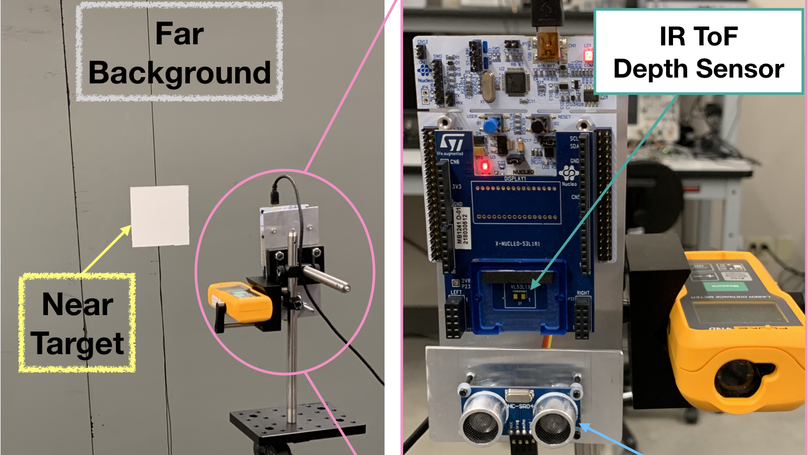
Ultrasonic sensors have dominated miniaturized depth measurement applications such as robot collision avoidance and walking cane hazard detection yet have limited spatial resolution. Optical time-of-flight (ToF) depth sensors offer the potential for improved spatial resolution, however, ToF depth-sensing cameras may be too large and power-hungry for hand-held applications. We address this gap by experimentally evaluating an infrared ToF sensor (the ST VL53L1X) that uses a single-photon avalanche photodiode array to provide coarse spatial resolution while remaining miniaturized and low-power, thus allowing the generation of hazard maps in hand-held applications. We develop methods and present characterization results for distance measurement accuracy, noise, error, and tolerable ambient illumination. The IR ToF sensor sustains accuracy better than 2% up to a distance of 3000mm for a 73% reflective target in the presence of zero interfering ambient light. We characterize the spatial resolution enabled by this region-of-interest and find off-axis pointing of up to 15.7° in steps of 2.5°. Many hazard detection systems may be moving, which dynamically changes the position and pointing of the depth sensor. We demonstrate the use of a 9-degree-of-freedom (3-axis accelerometer, gyroscope, and magnetometer) inertial measurement unit (IMU) to track sensor pointing. The ToF sensor combined with an IMU forms the basis for a miniaturized depth mapping solution that consumes 97.5mW when operating at 30Hz, and requires simple serial interfaces to a microcontroller.
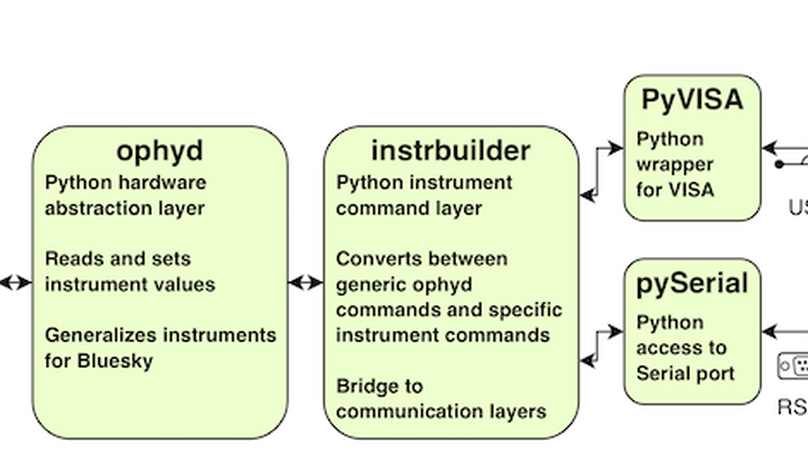
Tools that standardize and automate experimental data collection are needed for greater confidence in research results. The National Synchrotron Light Source-II (NSLS-II) has generated an open-source Python data acquisition, management, and analysis software suite that automates x-ray experiments and collects an experimental record that facilitates complete reproducibility. Here we show that the NSLS-II tools are not only useful for x-ray science at large-scale facilities by presenting an add-on package that adapts these tools for use in a small laboratory with common physics and electrical engineering instruments. The composite software suite eases and automates the execution of experiments, records extensive metadata, stores data in portable containers, and speeds analysis through tools for comprehensive searches. In total, this software suite increases the reproducibility of laboratory experiments. We demonstrate the software via the evaluation of two lock-in amplifiers — the miniature ADA2200 and the ubiquitous SRS SR810. The frequency resolution, signal-to-noise ratio, and dynamic reserve of the lock-in amplifiers are measured and presented. The usage of the software suite is described throughout these measurements so that the reader can implement the tools in their lab.
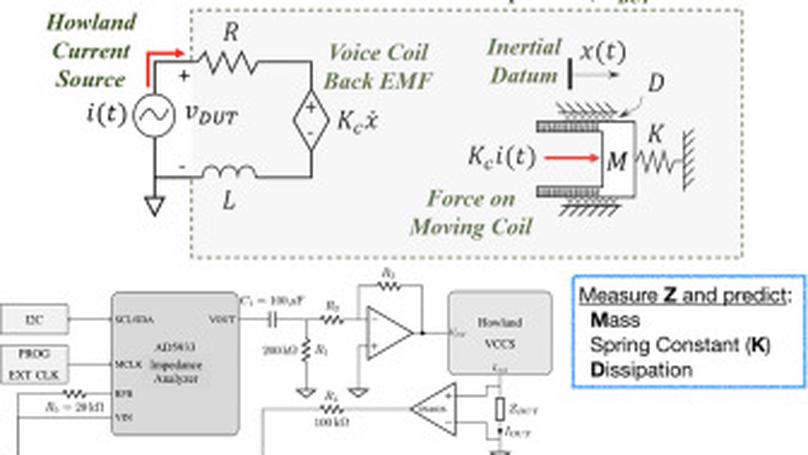
The voice coil motor (VCM) is a simple electromechanical linear motor used in space constrained applications such as pumps, precision positioning, and mobile camera lens actuation. The motion of a VCM is determined by the applied current as well as the mechanical parameters of mass, spring constant, and damping coefficient. VCM motion and mechanical parameters can be determined by a position sensor, but such a sensor may be too bulky for a miniaturized solution. To overcome this limitation, measurements of the VCM electrical impedance versus frequency can be combined with an electromechanical model to identify mechanical parameters. Here we detail an analytical model that relates the electrical impedance to mechanical parameters and demonstrate a miniaturized electrical impedance analyzer for VCMs designed around the AD5933 integrated circuit. The electrical instrument measures impedances of a typical VCM coil of ∼10 Ω with a signal-to-noise ratio of 84.7 dB. We display the effectiveness of the analytical model and impedance analyzer by identifying mechanical parameters of mass, spring constant, and damping coefficient using electrical impedance measurements alone. We experimentally modified the system mass and detected the changes using electrical impedance with a mean error of 5.6% and a Pearson’s correlation coefficient of ρ = 0.95. Repeated measurements of a single VCM configuration demonstrated that the natural frequency, knowledge of which is critical for optimal efficiency, was detected with a variation of 0.2%. A departure from harmonic motion was observed at low velocities. We explain this departure by adding static friction to the model of VCM motion. The AD5933-based miniaturized VCM driver and impedance analyzer coupled with a model that relates mechanical motion to electrical impedance is a viable instrument for in-situ diagnostics and tuning of VCMs.
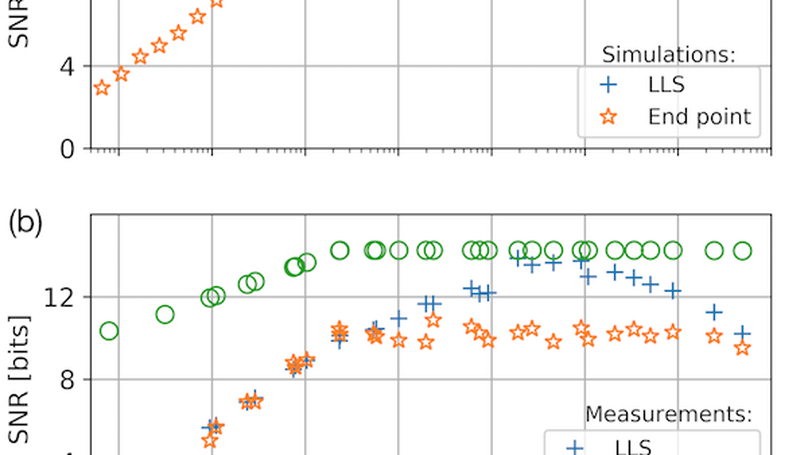
We present a light detection system (for point-of-care diagnostics) consisting of a multiple-sampling readout that forgoes the resolution limit set by a low-cost microcontroller ADC. Experimental measurements demonstrate a >5*10^6 input range and a noise floor of <210 fA.
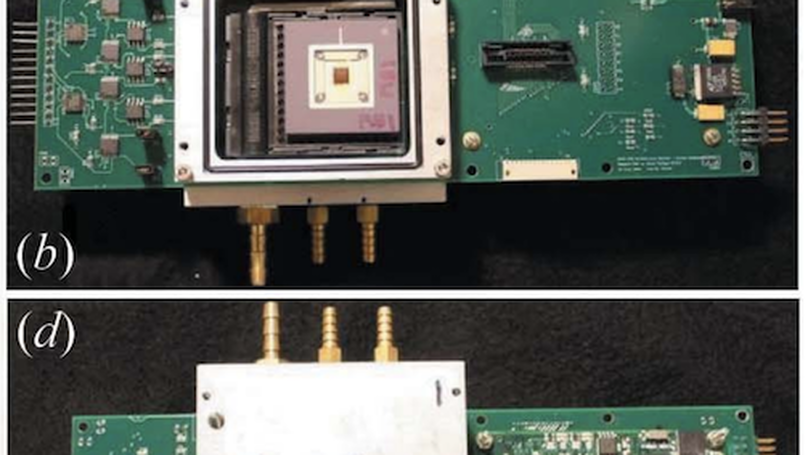
Dynamic X-ray studies can reach temporal resolutions limited by only the X-ray pulse duration if the detector is fast enough to segregate synchrotron pulses. An analog integrating pixel array detector with in-pixel storage and temporal resolution of around 150 ns, sufficient to isolate pulses, is presented. Analog integration minimizes count-rate limitations and in-pixel storage captures successive pulses. Fundamental tests of noise and linearity as well as high-speed laser measurements are shown. The detector resolved individual bunch trains at the Cornell High Energy Synchrotron Source at levels of up to 3.7×10$^3$ X-rays per pixel per train. When applied to turn-by-turn X-ray beam characterization, single-shot intensity measurements were made with a repeatability of 0.4% and horizontal oscillations of the positron cloud were detected.
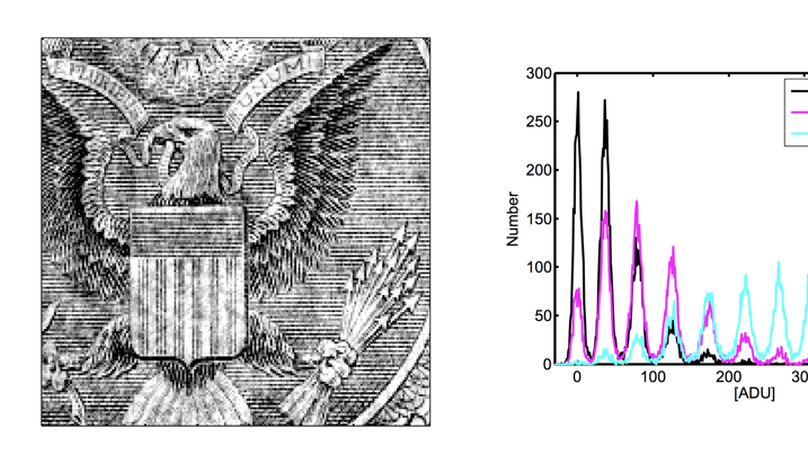
Test results are presented of a pixel array detector (PAD) developed for x-ray imaging at the Stanford Linear Coherent Light Source (LCLS). The basic module of the PAD consists of two bump-bonded chips: a reverse-biased silicon diode chip of 185 × 194 pixels, each of which is coupled by bump-bonds to a charge integrating CMOS ASIC with digitization in each pixel. The LCLS experiment requires a high signal-to-noise ratio for detection of single 8keV x-rays, a pixel full-well exceeding 1,000 8keV x-rays, a frame-rate of 120Hz, and the ability to handle the arrival of thousands of x-rays per pixel in tens of femtoseconds. Measurements have verified a pixel full-well value of 2,700 8keV x-rays. Single 8keV photon detection has been shown with a signal-to-noise ratio of > 6. Line-spread response measurements confirmed charge spreading to be limited to nearest neighbor pixels. Modules still functioned after dosages up to 75Mrad(Si) at the detector face. Work is proceeding to incorporate an array of modules into a large-area detector.
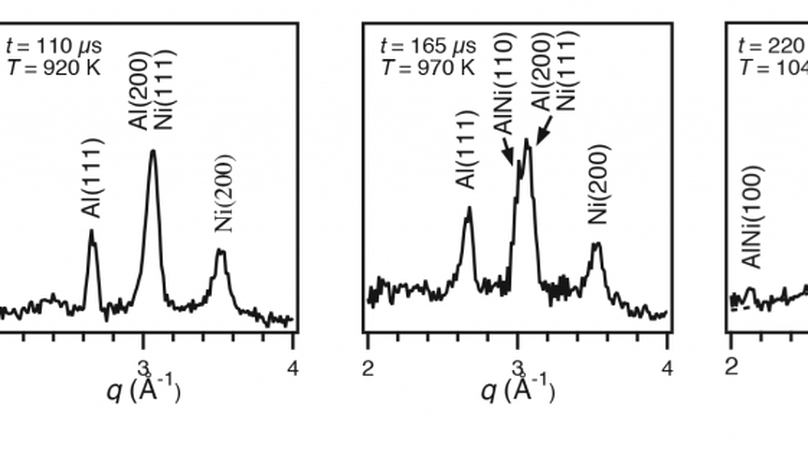
We have used self-propagating exothermic reactions in Al/Ni multilayers as a means to explore the effect of rapid heating on phase transformations. Using time-resolved synchrotron x-ray microdiffraction with an extremely fast detector, we were able to examine the reaction sequence in detail at heating rates of $10^{6}$ K/s. We observed that the intermediate phases formed during the self-propagating reactions are different from those formed at lower heating rates, even though the final phases are the same. In situ characterization is essential, as other means of studying self-propagating reactions such as quenching the reaction followed by ex situ analysis provide different-and potentially misleading—results.
Recent Publications